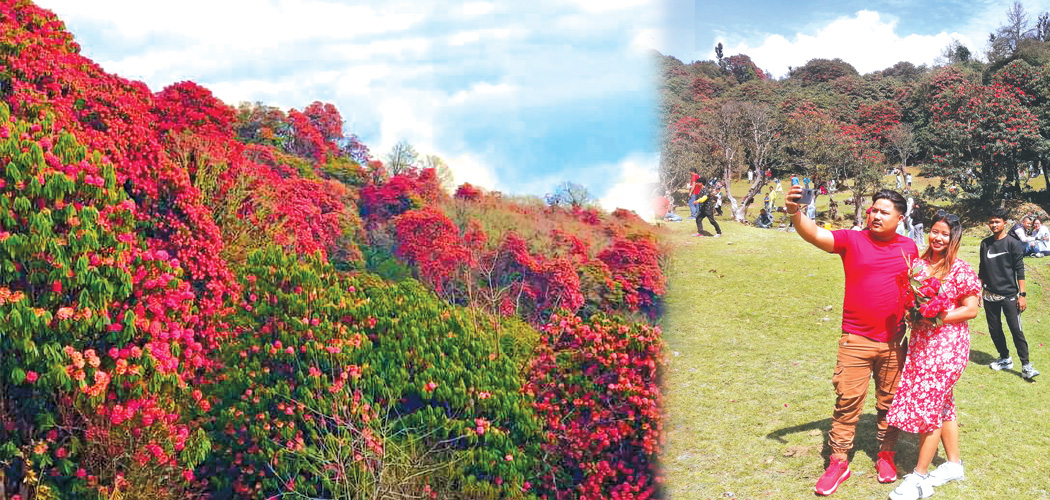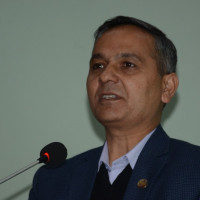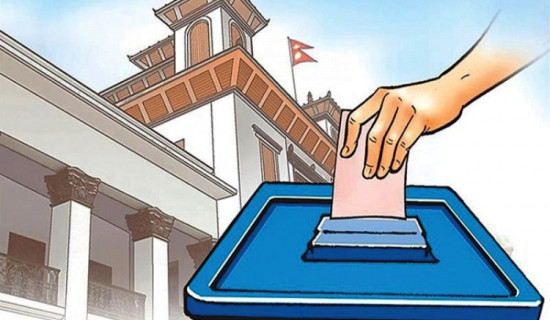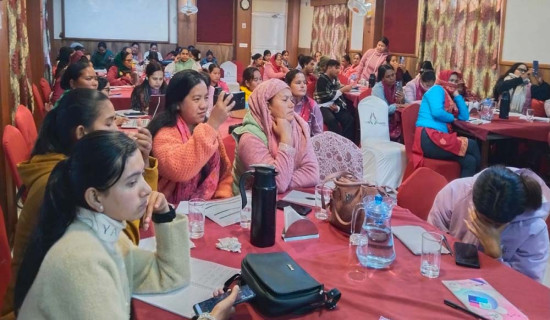- Wednesday, 24 December 2025
TMJ Rhododendron Capital of Nepal
Birat Anupam
Rhododendron is Nepal's officially declared national flower. The areas of Tinjure, Milke and Jaljale, popularly known as TMJ, are the 'rhododendron capital' of Nepal.
The blooming of rhododendron means blooming in Nepal. TMJ is the place where Nepal blooms. TMJ's rhododendron capital status was awarded owing to its availability of 28 out of 32 species of rhododendron found in Nepal. These statistics were compiled by IUCN in 2010.
Three Districts
If someone hails from Province 1 with curiosity about travelling, s/he does understand TMJ. The abbreviation of three sparsely located major hills, namely Tinjure Milke Jaljale. The TMJ covers an area of 285.26 square kilometres spanning over the Tehrathum, Sankhuwasabha and Taplejung districts of Province 1.
Interestingly, TMJ witnesses rhododendron flowering season during the period of the Nepali New Year of Bikram Sambat, which generally falls in mid-April. This is the reason TMJ gets thousands of tourists on a single day of the New Year celebration for Nepalis.
This year, too, some 30,000 visitors visited the TMJ area. This is the estimated number of travellers compiled by the Distrust Administration Office of the Tehrathum district. Basantapur, the headquarters of the local government, named after the Nepali name of rhododendron, Laligurans Municipality, is the gateway bazaar to TMJ. The Chief District Officer of Tehrathum, Anoj Kumar Ghimire, was present at this bazaar for maintaining security and estimation of the TMJ travellers.
On Baisakh 1 of 2079 BS (14 April 2022), I also made my footfall to this beautiful venue. I just roamed around RR Garden and the Pathibhara Temple area. However, I could feel the full bloom of rhododendrons there. The people had a visible attraction to click their pictures and film their TikTok videos there.
Tragically, among the various bloomed species of rhododendron species, pictures and videos were made mainly against the backdrop of red rhododendron. I could also see picnickers. There were some bikers also. People were also hiking to Tinjure hilltop, the first hilltop of TMJ. A few people go to Milke hilltop, as it is a little far away from Basantapur and located next to Guphapokharai. As far as Milke is concerned, almost nobody reaches there as it is remotely situated in Taplejung district with no access road track. Tinjure is in Tehrathum, and Jaljale is located in the Sankhuwasabha district.
TMJ does have altitude variation from 1700 metres to 5000 metres. This variation has a magnetic appeal to hikers and bikers. Plus, around 32 Himalayan ponds found there is another reason to travel to this place.
Major ponds famous for religious and cultural reasons for local folks are Panchapokharai, Lampokhari, Guphapokhari and Sabhapokhari. These beautifully located freshwater Himalayan ponds display the dancing shadows of the world's third tallest peak Mt. Kanchenjunga (8485 metres) Mt. Makalu (8463 metres) and other seriously adjoining Himalayan peaks. I, however, did not travel to any pond on New Year's Eve. I have already travelled to Guphapokhari and Panchpokhari. They do have majestic views and serene scenes.
Together with my friends Santosh Niraula aka 'Gaule Bhai' and Bikal Poudel did enjoy myself a lot in the TMJ zone. Our TMJ stay was a bit problematic as we could not find a hotel room for our accommodation in Basantapur.
TMJ was categorised among Nepal's top 100 destinations for Visit Nepal Year 2020. Though TMJ is home to numerous flora and fauna including the red panda, we could not see the red panda in the crowds.
TMJ is also a great venue for eco-tourism. As per the research paper titled 'Ecotourism Potential of Tinjure Milke Jaljale Area: A Rhododendron Capital of Nepal' which was collectively penned by Dipak Khadka, Sandesh Neupane, Baishal Sharma, Sweta Dixit, Prakash Chandra Wagle, Luna Thapa and Anesh Bhujel in 2019, these areas host 97 species of fauna, 178 species of herbs, 67 species of shrubs, 62 species of trees and 15 species of climbers.
Decreasing Forest
The sad part is that TMJ, these days, occupies just 15 per cent of rhododendron forest. This is a troubling scene not just for rhododendron conservation and ecotourism but also for the floral and faunal heritage of this upper hilly and lower Himalayan topography of Nepal. Although rhododendron conservation efforts at a governmental level were initiated in 1997, a lot needs to be done for its visible conservation.
During my new Year's Eve travelling to TMJ, I saw many visitors plucking out rhododendron flowers. Picnickers were not paying much attention to cleaning and sanitation. Litters were scattered haphazardly. The musical brouhaha was another troubling scene.
Yes, there were efforts to aware visitors not pluck flowers. A poem by Nepal's poet laureate Laxmi Prashad Devkota was placed by Division Forest Office Tehrathum to aware visitors importance of saving flowers. This creative warning was impactful to an extent but plucking out was going on regularly. No strong monitoring or legal measures were put into practice. As someone from Menchhyayem Rural Municipality of Tehrathum who is also a part of TMJ, I wish to see strong regulations and legal measures to punish wrongdoers in the TMJ zone. TMJ deserves strong preservation, protection and tourism promotion from civilians as well as governmental fronts. TMJ is Nepal's national eco treasure.
(Birat Anupam is an Itahari-based journalist who mainly writes on tourism, diplomacy and the environment)

















